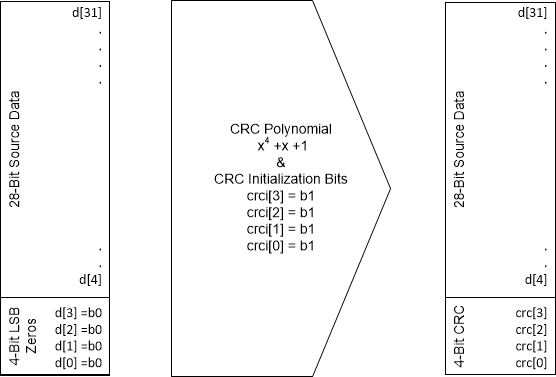ZHCSQR8A March 2023 – December 2023 TMAG5170D-Q1
PRODUCTION DATA
- 1
- 1 特性
- 2 应用
- 3 说明
- 4 Pin Configuration and Functions
- 5 Specifications
-
6 Detailed Description
- 6.1 Overview
- 6.2 Functional Block Diagram
- 6.3
Feature Description
- 6.3.1 Magnetic Flux Direction
- 6.3.2 Sensor Location
- 6.3.3 Magnetic Range Selection
- 6.3.4 Update Rate Settings
- 6.3.5 ALERT Function
- 6.3.6 Threshold Count
- 6.3.7
Diagnostics
- 6.3.7.1 Memory Cyclic Redundancy Check (CRC)
- 6.3.7.2 ALERT Integrity Check
- 6.3.7.3 VCC Check
- 6.3.7.4 Internal LDO Undervoltage Check
- 6.3.7.5 Digital Core Power-On Reset Check
- 6.3.7.6 SDO Output Check
- 6.3.7.7 Communication Cyclic Redundancy Check (CRC)
- 6.3.7.8 Oscillator Integrity Check
- 6.3.7.9 Magnetic Field Threshold Check
- 6.3.7.10 Temperature Alert Check
- 6.3.7.11 Analog Front-End (AFE) Check
- 6.3.7.12 Hall Resistance and Switch Matrix Check
- 6.3.7.13 Hall Offset Check
- 6.3.7.14 ADC Check
- 6.4 Device Functional Modes
- 6.5 Programming
-
7 Application and Implementation
- 7.1 Application Information
- 7.2 Typical Application
- 7.3 Best Design Practices
- 7.4 Power Supply Recommendations
- 7.5 Layout
- 8 Register Map
- 9 Device and Documentation Support
- 10Revision History
- 11Mechanical, Packaging, and Orderable Information
6.5.2.5 SPI CRC
The TMAG5170D-Q1 performs mandatory CRC for SPI communication. The data integrity is maintained in both directions by a 4-bit CRC covering the content of the incoming and outgoing 32-bit messages. The four LSB bits of each 32-bit SPI frame are dedicated for the CRC. The CRC code is generated by the polynomial x4 + x + 1. Initialize the CRC bits with b1111.
During the SDI write frame, the TMAG5170D-Q1 reads for the CRC data before executing a write instruction. The write instruction from the controller is ignored if there is any CRC error present in the frame. During the SDI regular read frame, the TMAG5170D-Q1 starts to deliver the requested data through SDO line in the same frame and notifies the controller of any error occurrence through the ERROR_STAT bit. If the device detects a CRC error in the SDI line, the device will invert the last bit of the SDO CRC in the same frame to promptly signal to a controller that the SPI communication is compromised. A controller can also determine the presence of a CRC error in the SDI frame by checking the Status11 bit in the next regular read frame.
 Figure 6-9 4-Bit CRC Calculation
Figure 6-9 4-Bit CRC CalculationUse the following XOR function equations to calculate the 4-bit CRC. Figure 6-9 describes the notations of these equations.
The following shows example codes for calculating the 4-bit CRC.
function logic [3:0] calculate_crc4;
input logic [27:0] frame;
logic [31:0] padded_frame;
logic [3:0] frame_crc;
logic inv;
integer i;
padded_frame = {frame, 4'b0000};
begin
frame_crc = 4'hf; // initial value
for (i=31; i >= 0; i=i-1) begin
inv = padded_frame[i] ^ frame_crc[3];
frame_crc[3] = frame_crc[2];
frame_crc[2] = frame_crc[1];
frame_crc[1] = frame_crc[0] ^ inv;
frame_crc[0] = inv;
end
return frame_crc;
end
endfunction